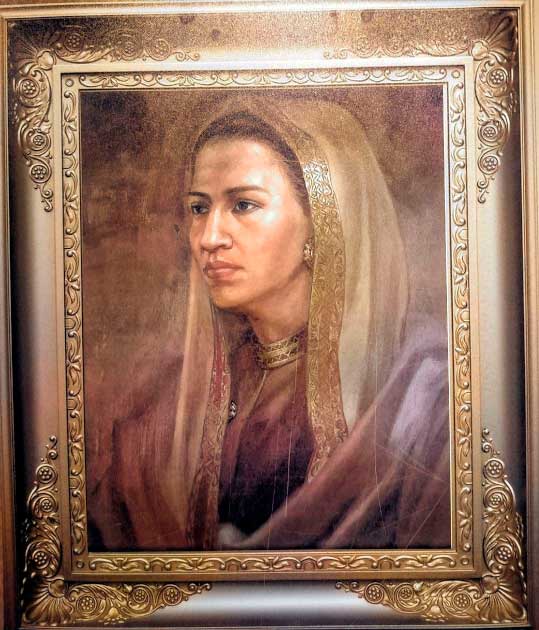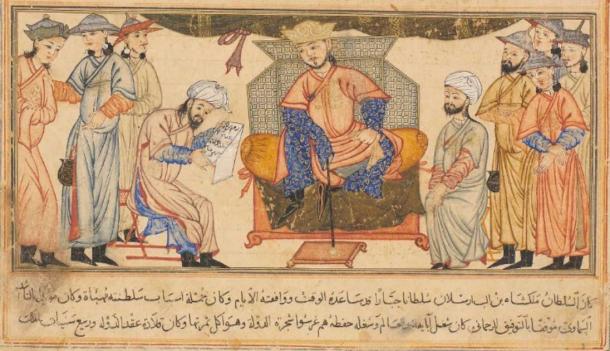
Five Female Monarchs of the Muslim World
The death of British Queen Elizabeth II earlier this year provoked retrospectives on her reign, as well as reflection on the rule of other female monarchs. Many powerful women leaders of the West are well-known, but there have also been numerous Muslim queens and sultanas, who ruled over powerful kingdoms.
1)Sultana Taj ul-Alam (ruled 1641-75)
Taj ul-Alam Safiatuddin Syah was born in 1612, the daughter of Iskandar Muda, king of Aceh (present-day Indonesia), and his royal wife, Putri Sani. Her father’s rule was known as the ‘golden age’ of Aceh, but he was a despot, ruling through military might rather than diplomacy. At the time of his death, he had no legitimate male heirs, having killed his own son just months before his own demise. Therefore, he nominated and placed his son-in-law, Iskandar Thani on the throne.
This move by Iskandar Muda disregarded the Orang Kaya, a league of nobles that helped run the kingdom. The name of the group of elites translates to ‘rich people’; as such, they played a very crucial role in the royal succession. As Sher Banu A.L. Khan wrote:
“The chronicles show that the elites played an important role in appointing and demanding rulers: weak rulers—those who possessed unacceptable personality traits injurious to the kingdom—were removed. This means that the nobility’s consent and acceptance of a candidate was a vital condition for a ruler’s succession.”
Iskandar Thani was an ostentatious and extravagant ruler. His reign saw the depletion of the royal treasury, as the king was ordering extravagant jewelry from the Dutch. After just five years in power, he died mysteriously, leading many historians to conclude that he had been murdered. His death led to a crisis because there were no legitimate male heirs with a proper royal background. When a few among the Orang Kaya nominated themselves to be king, their fellow Orang Kaya didn’t want to see one of their own on the throne, so attention turned to Safiatuddin, the daughter of Iskander Muda and widow of Iskandar Thani. Hossein Kamaly wrote in his book, A History of Islam in 21 Women:
“When it comes to succession, the Sultanate had no hard-and-fast rules. A suitable candidate had to be a native of Aceh and of royal birth and had to demonstrate commitment to the principles of justice, as defined in Islamic terms and understood in Malay tradition or custom (adat).”
Since there was no need for the monarch to be male, within three days of Iskandar Thani’s death, Safiatuddin ascended the throne with the approval of the Orang Kaya and the ulama (Muslim scholars of Islamic law) at the age of 29. She inherited a throne in trouble because the Dutch East India Company was slowly establishing power in neighboring territories. Despite numerous political clashes with the Dutch, where they were trying to gain a monopoly on the tin and pepper trade, Aceh held its own against the pressure and even retained their vassal states.
Sultana Taj ul-Alam Safiatuddin Syah successfully ruled Aceh for thirty-five years, paving the way for future queens. Dutch scholars have written that during the queen's rule, it felt like Aceh had always been ruled by a female monarch. After her death in 1675, three successive queens took her place.
- Sobekneferu’s Legacy: The Sacred Places of Egypt’s First Female Pharaoh
- Sultan Razia: The First and Only Female Royal of Delhi

Painting of the Sultana Taj ul-Alam Safiatuddin Syah, who ruled the Sultanate of Aceh for thirty-five years. (Hanataturi / CC BY SA 4.0)
2)Sultana Shajar al-Durr (ruled 1249-1257)
Shajar al-Durr was the first and only woman to sit on the Egyptian throne after Pharoah Cleopatra VII, who had reigned thousands of years earlier. Shajar al-Durr was born a slave, but after her marriage to Malik al-Salih Najm al-Din Ayyub, the eighth sovereign of the Ayyubid dynasty, Shajar rose to the rank of queen consort. However, she was thrust into a position of power when the Seventh Crusade, led by King Louis IX, invaded Egypt.
Her husband, Malik al-Salih, died in the middle of the conflict, and Shajar had to hide her husband’s death to keep the soldiers' spirits up. She issued orders under her husband’s name and won a decisive victory, even capturing the French king. Her intelligence and worth were recognized by the nobles, who chose to place her on the throne when Malik al-Salih’s son failed to be a good leader. Her first act was to negotiate an enormous ransom for King Louis IX of France.
Unfortunately, Egypt was under the control of the Caliphate of Baghdad, and the Caliph al-Musta’sim violently opposed the accession of a woman to the Egyptian throne. While Shajar al-Durr didn’t demand any grand titles, she did ask for simple recognition of her talents and capability as the Egyptian head of state. In response to her accession, the caliph sent a simple message that was intended to humiliate. As Fatima Mernissi wrote in her book, “ The Forgotten Queens of Islam”:
“The Caliph then sent to the Egyptian emirs the famous message, so humiliating to her, in which he proclaimed that he was ready to provide them with some capable men, if no more existed in Egypt, since they were reduced to choosing a woman.”
Despite the caliph's rejection, Shajar al-Durr adopted the title Malikat al-Muslimin, which means “Queen of the Muslims.” However, just 80 days into her reign, immense pressure from external forces led to Shajar agreeing to a second marriage, with Izz al-Din Ayubek. A condition for the marriage was that Ayubek had to divorce his first wife, which he did.
Shajar al-Durr may have held the reigns of the kingdom, but her new husband didn’t like being sidelined and planned to marry a foreign princess to increase his control. When Shajar found out, sources claim that she may have orchestrated his assassination. In the end, Ayubek’s son, Mansur, took control with the aid of the Mamaleek, Egyptian nobles.
Shajar al-Durr was handed over to Mansur’s mother, the previous wife of Ayubek, who exacted terrible revenge on the former queen.
“Shajar al-Durr, the former Sultana was beaten to death by wooden shoes, then her body was dragged by the feet to the top of the citadel and then thrown to her death from the top. Shajar’s body was torn apart by dogs before they took pity and buried her remains within the mausoleum, she had constructed herself.”
Despite her short reign, she achieved a great military victory, commissioned grand monuments, and tried to make Egypt a grand empire. Unfortunately, she was surrounded by men who felt threatened by her power and authority, and that is why she met such a gruesome fate.
- Killer Queens: 5 of Ancient History’s Most Outstanding Female Rulers
- Queen Tamar: The Confident Female Ruler of the Georgian Golden Age

Mausoleum of Shajar al-Durr in al-Khalifa neighborhood, Cairo (R Prazares / CC BY SA 4.0)
3)Sultana Khadija (ruled 1347-79)
Sultana Khadija of the Maldives is another example of a female monarch with a long, successful reign. In 1347, after a vicious power struggle, Sultana Khadija, daughter of Sultan Salah al-Din Salih, ascended the Maldives throne and ruled for 33 years. It was during her reign that the famous explorer Ibn Battuta traveled to the Maldives and recorded important information regarding Khadija’s enthronement:
“The only survivors from the ruling house were his three sisters…The inhabitants of the Maldive islands preferred for sovereign Khadija and she was the wife of their orator (khatib) Jamal-ud-din who became vezir.”
Orders were issued in the name of the sultana and a khutbah, a religious address including recognition of the sovereign, was even proclaimed in her name. This was something that had never been done for any other female queen, as the khutbah was thought to have been reserved for a male ruler. Sultana Khadija was a wise ruler and reigned over her kingdom with the help of her husband. She died in 1379 and was replaced by her younger sister, Myriam.
4)Sultan Regent Terken Khatun (ruled 1072-1094)
Terken Khatun was the second wife and chief consort of the Sultan of the Seljuk Empire, Malik Shah I. She was a Qarakhanid princess and the daughter of Tamghach Khan Ibrahim, a great king of his era. To secure her position further, she gave birth to the heir of the empire, Mahmud I.
Her life changed when her husband was assassinated in 1092. Fearing for her son’s life, and because he was still a minor, Terkun took power in his name. Her first act as regent was to secure her rule. Her toughest challenge came from the Abbasid Caliph al-Muqtadi (coincidentally also her son-in-law), who was opposed to having a woman as ruler and thus would not allow the khutbah to be proclaimed in her name.
Despite the opposition, she was able to improve the political situation in her country, trying to pave the way for her son. Unfortunately, she died suddenly during a conflict, tragically followed a month later by her son.

Malik-Shah I seated on his throne, circa 1315. His death placed Terken Khatun on the throne as regent, although her reign as a female monarch was quite short. (Public Domain)
5)Queen Arwa al-Sulayhi (ruled 1065-1138)
Arwa Bint Ahmad al-Sulayhiyya was the queen of Yemen and held power for almost half a century. She is said to have enjoyed the privilege and unquestioned position of head of state. Like Sultana Khadija, Arwa had a khutbah proclaimed in her name.
Arwa suffered the loss of her parents at a young age and was raised in the court of her paternal uncle, Ali al-Sulayhi, and his queen, Asma Bint Shihab al-Sulayhiyya. It was in this environment that Arwa was raised by her strong-willed aunt, who ruled as an equal with her husband. One difference between Arwa and her aunt Asma was that Asma ruled without a veil, attending meetings with her face uncovered; however, Arwa chose to remain veiled. Impressed by Arwa’s intelligence, at age 17, Ali and Asma married her to their son, al-Mukarram. After the death of Asma, Arwa assumed control with her husband, al-Mukarram, who granted her the same respect and freedom that had been granted to his mother.
Fatima Mernissi wrote in her book, The Forgotten Queens of Islam:
“The historians emphasize that ‘Arwa gave her full attention to military conquests, needing to prove that the dynasty was still as strong as ever despite the loss of its great leader Ali and the disability of al-Mukarram. In politics, unlike in music, being a woman does not soften behavior.”
Another 19th century historian, Yasin al-Khatib al-Amri, described Arwa as a sovereign who “perfectly understood how to manage the affairs of state and of war.”
Queen Arwa al-Sulayhi was a successful female monarch, leaving behind beautiful architectural monuments like the famous Sana’a mosque. She set up cultural and religious centers, making sure that the teachers and scholars were paid well. Queen Arwa was an intellectually gifted and efficient queen, as well as a matchless administrator.

Queen Arwa's Mosque, as seen from the Palace of Queen Arwa (Mufaddalqn / CC BY SA 3.0)
Conclusions about Female Monarchs
The circumstances surrounding the ascension of these female monarchs were each unique, but there is no denying that once they were seated on the throne, they carried out their duties with vigor and responsibility. They protected their people from invaders, kept their economies thriving, and helped influence the cultural and spiritual renaissance of their respective kingdoms. They deserve to be remembered for their extraordinary talents and bravery that kept their people safe and their empires prospering.
Top Image: Female monarchs have been rare, but not unheard of, across the world. Like their male counterparts, they had mixed track records. Source: FrankBoston / Adobe Stock
By Khadija Tauseef
References
Tauseef, K. July 4, 2022. Shajara al-Durr. World History. Available at: https://www.worldhistory.org/Shajara_al-Durr/
Khan, S. 2018. Sovereign Women in a Muslim Kingdom. Flipside Digital Content Company Inc.
Kamaly, H. A History of Islam in 21 Women. Simon and Schuster, 2019.
Mernissi, F. The Forgotten Queens of Islam. U of Minnesota Press, 1993.
Metcalf, B. Islam in South Asia in Practice. Vol. 33. Princeton University Press, 2009.















